

Because the paper he uses is thin (to conform to the contours of the fish) and because of the amount of water used in the printing process, the paper tends to buckle after the print is pulled.
To flatten out the paper, Ray uses a wet mount process to glue the print to a piece of archival paperboard.
For this demonstration, he used a smaller print which he brought with him since the prints must dry completely before being mounted, and the demonstration print might not be sufficiently dried to use it for the mounting demonstration
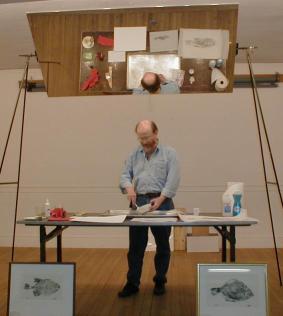
The first thing to do is to wet both the paperboard
mount and the print itself. In this photo, Ray is wetting
the print using a large, Japanese brush.
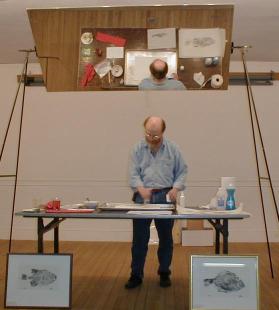
The next step is to coat the board with wheat paste.
He uses archival wheat paste. One important benefit of
using wheat past is that it can be softened later with
water to fix any problems with the print.
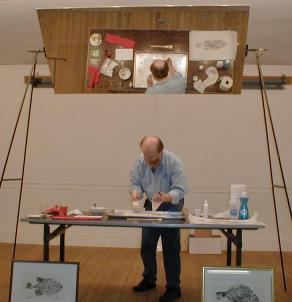
Ray carefully smooths the paper down to the mounting board,
supporting the print on his forearm to avoid tearing it.
He uses another large, Japanese brush to brush out the wrinkles.
This procedure requires great care to obtain good results.
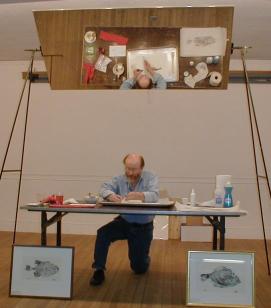
Sometimes he has to get close in order to remove the
tiniest of bubbles, wrinkles, and specks of dirt.
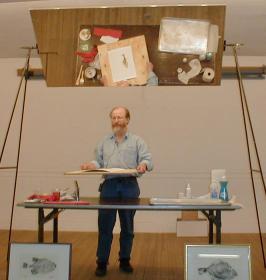
Once the print is mounted, the entire board tends to bow,
as you can see in this photo. To remove the bow, Ray
staples the mounting board down to a plywood sheet.
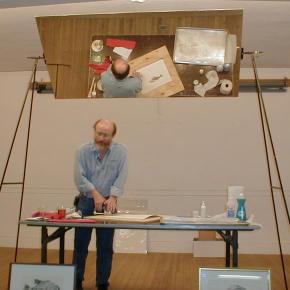
Here you can see Ray stapling the print down to the plywood.
He says that he uses lots of staples to make it flat.
When the print dries, it will stretch out and become flat.
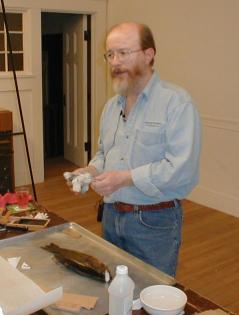
After the demo, Ray stayed around to answer questions.
This was an excellent and informative demonstration.
Thank you, Ray.
Ray Bliss Rich has appeared on the Martha Stewart Living Television Show.
Hillsboro, New Hampshire Artist, Ray Bliss Rich demonstrated the gyotaku printmaking techniques featured on Martha Stewarts's show and many tricks of the trade not broadcast.
Gyotaku prints are original artworks completed using an actual fish as a relief-printing block. While similar to other block printing methods (for example, woodblock), there are special complications using an actual fish, particularly the body chemistry and the irregular shape of the fish. Mr. Rich demonstrated preparation of the fish for printing, application of ink, pulling the print, and the special handling required for proper mounting.
Ray Bliss Rich has won numerous awards for his gyotaku printmaking, most recently earning second place in printmaking at the Vermont Arts and Fine Crafts Festival at Stratton Mountain. You can see his artwork at shows and galleries throughout New England, including New England Goods, Rockport; Winchester Art & Frame, Winchester; Cape Gallery, Falmouth; NOA Gallery in Groton Center; or on his web site, www.sumi-art.com.
Mr. Rich has been creating gyotaku prints since 1983, when he discovered the process while on sabbatical in Houston, Texas. It was a natural fit with his sumi-e paintings and his enjoyment of fishing. He is self-taught in the technique, which has won him national recognition since his appearance on the Martha Stewart Show.
Ray has Bachelor of Arts and Master of Education degrees. He has 18 years' experience as a counselor and associate professor. A full-time artist since 1993, he has won over 35 awards for his artwork. He has done art demonstrations for numerous organizations, including the Hood Museum at Dartmouth College.